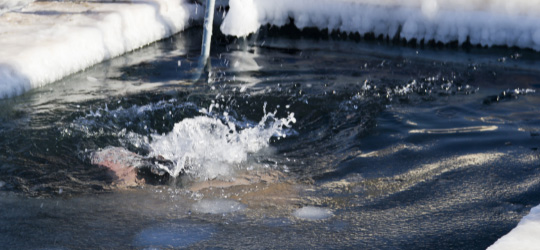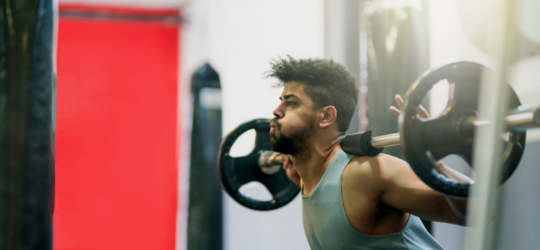Whether you wake up with an icy shower or have seen any videos of Wim “The Ice Man” Hof, someone has probably told you that cold plunges are great for your health.
Anyone who’s jumped into cold water understands the enormous jolt of energy and endorphins that immediately surge through your body.
But what is cold water immersion (CWI) actually doing for you? And where does it fit within an intelligent recovery plan?

Like all other recovery/regeneration methods, the how always comes back to the autonomic nervous system. Remember, this is made up of the sympathetic “fight or flight” and parasympathetic “rest and recover” systems.
When you initially jump into frigid water, the “cold shock” response is classic sympathetic system at work: your heart races and your blood pressure skyrockets as your vessels constrict.
That voice inside your head that tells you to “GET OUT OF THE WATER,” is a full-blown flight response. Being freezing cold is stressful.
If you are too cold, for too long, you can die. There are very real survival mechanisms that get turned on when you jump in icy water.
One of the main things that quickly happens is your core temperature is lowered and your blood vessels contract to drive blood to your heart, lungs, and other organs. This can help stimulate the immune system, reduce pain, and decrease inflammation.
It sounds like CWI is a perfect recipe for recovery, but there’s a catch…
When to use CWI… and when not to.
Inflammation, just like stress, isn’t always a bad thing. In fact, your inflammatory response is actually part of a signaling pathway that tells your body to adapt and improve after your workouts.
It’s a big piece of how the body knows that tissues have been stressed and need to be repaired. It’s through this repair process that they become more fit.
So, here’s the catch with CWI…
On the one hand, using CWI immediately after workout has been shown to have an impact by quickly reducing core body temperature and causing a faster restoration of explosive power and strength back to baseline levels.

Sounds like a good thing, right?
The problem is that at the same time, when you dampen your inflammatory response right after a workout with a cold shower, bath, or float (especially if you do this repeatedly), you run the risk of decreasing your body’s signals to improve.
In other words, the cost of the short-term recovery benefits is that they may interfere with the potential long-term benefits of training.
Research has shown this to be particularly the case when it comes to trying to build bigger, stronger muscles.
That means that whether or not you should use CWI after a workout, practice, or game, depends on the situation.
If you’re training twice a day or have a limited amount of time to recover before you have to train or perform again, it can make sense to use CWI to help speed up recovery.

If your HRV and recovery scores in Morpheus are showing that you’re heading in the wrong direction, particularly if you’re seeing your HRV persistently higher than normal, it can be valuable to use CWI to tamp down inflammation and give your body a recovery boost.
In this case, the benefits can outweigh the potential costs.
But if your recovery is generally where it needs to be and you can control when and how hard you train, it’s generally best to avoid finishing your workout or practice by jumping in an ice bath.
What about a morning shower or plunge?
A morning cold shower or plunge is much less likely to have an impact on your training from the previous day.
Here, the primary benefits are likely the feeling you get from the endorphin rush (many people report an overall improvement in mood), and the potential for a boost in immune function.
So, if you enjoy incorporating some form of cold into your daily morning routine and it makes you feel better, chances are good that it’s helping you.
The key is to recognize that just like anything else, your body will get used to cold exposure. If you do it every single morning, it will lose its effectiveness. Cycling through periods of doing it and taking a break is a good way to maximize the benefits.
How cold and for how long?
Just like with training, we can think of the stress of CWI in terms of volume and intensity. The “intensity” is the water temperature and the “volume” is how long you stay in it.
And just like with training, the key is to start off with less volume and intensity and only build up to more as necessary.
If you use too much, the cost of the stress will outweigh the benefits, no matter when you do it.
A general recommendation for water temperature range based on the research is between 12-14° C (54-57° F). When it comes time, anywhere from 10-17 minutes of total exposure within those temperature ranges is common.
Always keep in mind that the colder the water temp you use, the shorter the total amount of time you need to be in it to have the same benefits.
It’s also important to consider that total body immersion, particularly if you put your head under water, is a much higher level of stress than a cold shower.
As always, the devil is in the dose. Monitoring your HRV and recovery with Morpheus can help you make sure you’re on the right track.
Action step
If you’ve never tried any form of CWI, a cold shower is the easiest way to get started. Even just a minute or two in the morning can help your body build tolerance before you take the next step.
Monitor your HRV closely using Morpheus, especially during prolonged periods of stress. If you start to see signs of parasympathetic overreaching, try using CWI to get back on track.
